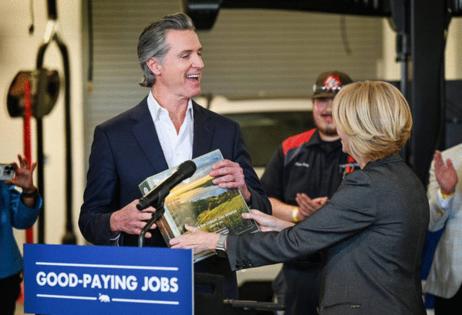Calif. Gov. Gavin Newsom has a plan to boost Central Valley jobs. Experts aren't sure it'll be effective
Published in News & Features
SACRAMENTO, Calif. — Experts were mixed on the potential effectiveness of Gov. Gavin Newsom’s new plan to promote higher-paying jobs in the Central Valley, where the economy hasn’t seen the sort of growth other parts of California have enjoyed.
Newsom on Monday made the second of three planned appearances in the Central Valley to tout his “California Jobs First” plan, which his office expects to publish in the new year.
He announced the initiative last week as part of an effort to bolster higher-paying jobs in areas like the Sierra-San Joaquin area that have not reaped the benefits of California’s overall booming economy.
Appearing from the National Cement plant in Kern County, the governor pledged $120 million in competitive state grants to bolster job-creating projects but offered few other specifics beyond previously available regional reports.
His office said in a statement it would publish its larger economic blueprint “early next year” as part of the statewide effort to bolster “clean economy” jobs in the wind, solar, and carbon management sectors.
But Mark Baldassare, survey director at the Public Policy Institute of California, said the impact of economic policies such as the blueprint initiative often take years to transpire.
He compared Newsom’s plan to the Inflation Reduction Act, a Democratic-authored congressional effort that President Joe Biden signed in 2022. It aimed to stabilize soaring food and gas costs, which have since eased.
“Unless we go into some kind of economic boom in the next 12 months, when we’re talking about doing things that will create change, from a policy perspective, it can take a year or longer,” Baldassare said. “He’s got a couple more years left as governor. (There) could be a difference by the time his tenure ends.”
Newsom’s term ends in 2026 and he can’t run for governor that year. He is taking steps that suggest he’s considering a run for higher office.
Sen. Roger Niello, a Fair Oaks Republican and frequent Newsom critic, derided the recent economic initiative announcement as political course-correction in the wake of Kamala Harris’ loss to Donald Trump and Newsom’s low approval ratings.
“Clearly the governor is concerned that 10 counties in California that previously voted blue, voted red this time,” Niello said, referring to the gains that Trump made in the Nov. 6 election.
Gökçe Soydemir, a Stanislaus State business professor, said further investment in the Sierra-San Joaquin area, where Newsom appeared last week, was much needed.
“This area has been neglected relatively to the coastal areas,” he said.
The San Joaquin Valley’s economic trajectory has improved in the last year after inflation cooled, but unemployment and stagnant wages persist, according to a forecast Soydemir and Stanislaus State published Tuesday.
The Central Valley is one of the fastest-growing areas in the country, driving a demand for housing and professionals like doctors and nurses, Soydemir said. “From that standpoint, the jobs and employment strategies Newsom is considering are vital.”
Newsom appeared last week in Fresno alongside former mayor and Central Valley Community Foundation president Ashley Swearengin to announce the Sierra San Joaquin Jobs Initiative. The initiative, a draft of which was published in August, calls for the state to invest $58 billion in the area over the next 20 years.
Despite Newsom’s unpopularity in the area and lack of details in his proposal, Soydemir said the call to invest in areas like the San Joaquin Valley were “on the ball.”
“We need more social programs here. Population growth is taking place here, and he can’t ignore this area,” Soydemir said. “Whatever he does he’ll be unpopular. If you’re a (Golden State) Warriors fan, you’ll never be a (Sacramento) Kings fan.”
_____
©2024 The Sacramento Bee. Visit sacbee.com. Distributed by Tribune Content Agency, LLC.







Comments